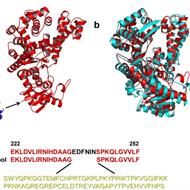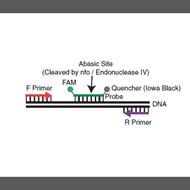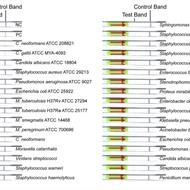
Optimization of an isothermal recombinase polymerase amplification method for real-time detection of Potato virus Y O and N types in potato
Author: Babujee L, Witherell RA, Mikami K, Aiuchi D, Charkowski AO, Rakotondrafara AM.
Potato virus Y (PVY) is a global challenge for potato production and the leading cause of seed crop downgrading and rejection for certification. Accurate and timely diagnosis is key to effective control of PVY. In this study, an recombinase polymerase amplification (RPA) …

Two Approaches to Enhance the Processivity and Salt Tolerance of Staphylococcus aureus DNA Polymerase.
Author: Zhai B, Chow J, Cheng Q.
In this article, two engineering-strategies were carried out to enhance the processivity of the DNA polymerase used in recombinase polymerase amplification (RPA).

Rapid molecular detection of macrolide resistance
Author: Nelson MM, Waldron CL, Bracht JR.
Emerging antimicrobial resistance is a significant threat to human health. In this study, recombinase polymerase amplification (RPA) is used to detect the antimicrobial resistance gene mef(A) from raw lysates without nucleic acid purification

Detection of Listeria monocytogenes and Staphylococcus aureus via duplex recombinase polymerase amplification
Author: Guo Z, Chen Z, Liu X, Chen J, Chen G, Liu Z, Yang G, Lan Q.
Listeria Monocytogenes (L. Monocytogenes) and Staphylococcus Aureus (S. Aureus) can cause serious foodborne illnesses. In this study, a duplex assay utilizing recombinase polymerase amplification (RPA) was developed to detect L. Monocytogenes and S. Aureus simultaneously

Development of a lateral flow recombinase polymerase amplification assay for rapid and visual detection of Cryptococcus neoformans/C. gattii in cerebral spinal fluid.
Author: Ma Q, Yao J, Yuan S, Liu H, Wei N, Zhang J, Shan W.
For definitive diagnosis of cryptococcal meningitis, Cryptococcus neoformans and/or C. gattii must be identified within cerebral spinal fluid from the patients. In this study, an assay combining recombinase polymerase amplification (RPA) with lateral flow (LF) was developed to detect C.neoformans …

Rapid detection of Mycobacterium ulcerans with isothermal recombinase polymerase amplification assay
Author: Frimpong M, Ahor HS, Abd El Wahed A, Agbavor B, Sarpong FN, Laing K, Wansbrough Jones M, Phillips RO
This study successfully utilizes RPA for the detection of M. ulcerans in Buruli ulcer disease

Sensitive and rapid visual detection of Salmonella Typhimurium in milk based on recombinase polymerase amplification with lateral flow dipsticks.
Author: Hu J, Huang R, Sun Y, Wei X, Wang Y, Jiang C, Geng Y, Sun X, Jing J, Gao H, Wang Z, Dong C.
Salmonella Typhimurium (S. Typhimurium) can cause serious foodborne diseases. In this study, an assay combining recombinase polymerase amplification (RPA) with lateral flow dipsticks (LFD) was developed to detect S. Typhimurium in milk.

Rapid and sensitive detection of goose parvovirus and duck-origin novel goose parvovirus by recombinase polymerase amplification combined with a vertical flow visualization strip.
Author: Liu W, Yang Y, Du S, Yi H, Xu D, Cao N, Jiang D, Huang Y, Tian Y.
Goose parvovirus (GPV) is one of the most serious viral pathogens in goslings. Recently, a new pathogen to the Chinese mainland—duck-origin novel goose parvovirus (N-GPV)—was found to be 90.8–94.6% identical to the nucleotide sequence of GPV, and typically causes growth disorders and high …

Development of a rapid and sensitive recombinase polymerase amplification‐lateral flow assay for detection of Burkholderia mallei.
Author: Saxena A, Pal V, Tripathi NK, Goel AK.
Early diagnosis of glanders is critical for timely treatment in humans and disease containment in animals. In this study a recombinase polymerase amplification-lateral flow assay has been developed for early and accurate detection of B. mallei.

A novel onsite and visual molecular technique to authenticate saffron (Crocus sativus) and its adulterants based on recombinase polymerase amplification.
Author: Zhao M, Wang B, Xiang L, Xiong C, Shi Y, Wu L, Meng X, Dong G, Xie Y, Sun W.
Saffron (Crocus sativus), one of the most expensive herbs in China, has been subject to various types of adulteration as a consequence of its high price and limited production. This study describes a sensitive, efficient and simple technique for on-site …

